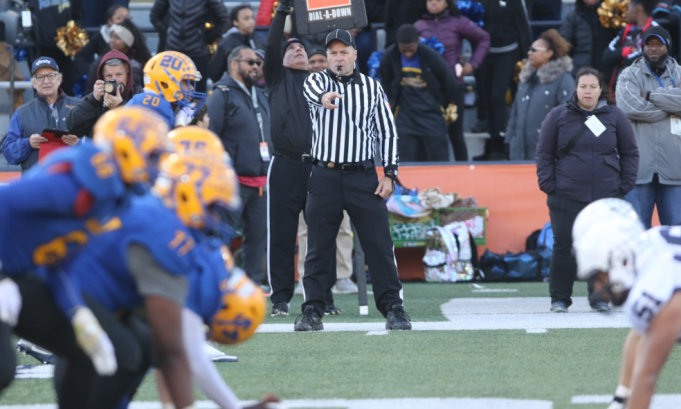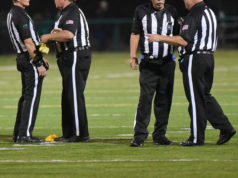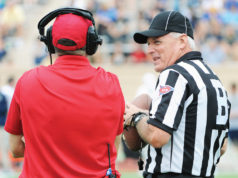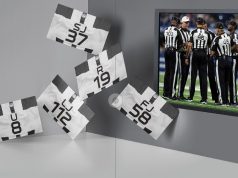Judgments are a large part of football officiating. All rules require some degree of judgment. Perhaps the simplest application is determining whether a team has too many players on the field. All an official must do is count properly (it doesn’t always happen). At the other end of the spectrum are calls that require a large degree of judgment. Those include pass interference, holding and targeting.
Fouls in and around the neutral zone are not usually thought of as requiring much discretion. After all, a false start is a false start. However, it is not quite that simple. When there is movement before the snap, officials must not only determine if the act was a foul, but they may also have to decide which team violated the rules. Unless otherwise noted, the material applies to both NFHS and NCAA rules.
Encroachment/offside
In NFHS play, after the ball is ready, it is encroachment if any team B player breaks the plane of the neutral zone. The ball remains dead. In NCAA, defenders may break the plane before the snap as long as they don’t touch the ball or an opponent and are back on their side of the line at the snap. Getting “caught” in the neutral zone at the snap is a five-yard, liveball, offside foul simultaneous with the snap. “Interference” with an opponent or the ball is a five-yard, dead-ball foul.
Play 1: Nose tackle B1 anticipates the snap count and (a) charges into center A2, or (b) touches the ball before it is snapped. Ruling 1: A dead-ball foul, five yards, succeeding spot, hands-on-hips signal.
Play 2: Same as play 1 except B1 enters the neutral zone, stops just short of contact with A2 and (a) does, or (b) does not get back to his side of the zone before the snap. Ruling 2: In NFHS, in both cases, the ball remains dead. B1 encroached as soon as he entered the zone. Under NCAA rules, in (a), no foul. In (b), it is a live-ball, offside foul. Team A will get to choose the result of the play or have a five yard penalty marked off from the previous spot. When a team A lineman moves after a defender breaks the plane of the neutral zone, the wing officials in an NCAA game must determine whether a false start has occurred. If a player on the line moves as a reaction to a team B player moving in the neutral zone, regardless of whether he makes contact or enters the neutral zone, it is not a false start. The player who moves must be in the vicinity of the violating team B player, meaning head-on or on either side of him.
Play 3: Team A breaks its huddle and comes to the line. All players are set for at least a second as A1 barks signals. Suddenly, lineman B2, who is directly opposite A3, breaks into the neutral zone. After B2 enters the neutral zone, A3 (a) remains still as B2 returns to his side of the neutral zone, or (b) lifts his hand from the ground in anticipation of contact. Ruling 3: In NFHS play, in all cases, B2 encroaches when he breaks the plane of the neutral zone and the ball remains dead. Under NCAA rules, in (a), there is no foul and play proceeds. In (b), B2 is guilty of a dead-ball, offside foul. For the offense, any player other than the snapper who lines up in the neutral zone following the ready and after the snapper has touched (or simulated touching in NCAA) the ball, is guilty of encroachment; a five-yard, dead-ball foul. Both codes allow the snapper to be in the neutral zone. NCAA prohibits any part of the snapper’s body to be beyond the neutral zone, while NFHS permits the snapper’s hands to be beyond the foremost point of the ball if they are touching the ball (NFHS 7-1-7c; NCAA 7-1-3a4).
Play 4: Tackle A1 breaks from the huddle, lumbers up to his position and plants himself in the middle of the neutral zone. At the time A1 took his position, the snapper (a) had, or (b) had not placed his hands on the ball. Ruling 4: In (a), the whistle is blown immediately, A1 has encroached. In (b), encroachment does not occur until the snapper touches the ball. If A1 gets back to his side of the neutral zone before the snapper touches the ball, there is no foul.
False starts
The false start is likely the most often called foul in football. After the ball is marked ready and before the snap, it is a false start by any team A player if a charge is feigned or there is any shift or movement which simulates action at the snap or if any team A lineman, other than an end, moves his hand(s) after having placed a hand on or near the ground. The latter refers to a “restricted” lineman and there is a subtle rules difference which would most likely be a factor in a scrimmage kick formation.
Play 5: Linebacker B1 fakes a blitz without entering the neutral zone which causes interior lineman A2 to prematurely lift up from his threepoint stance. Ruling 5: A false start by A2, a five-yard dead-ball foul. Other examples of prohibited movement include: a lineman moving his foot, shoulder, arm, body or head in a quick, jerky movement; the snapper shifting or moving the ball or moving his thumb or fingers, flexing elbows, jerking his head or dipping shoulders or buttocks; the quarterback chucking hands at the snapper, flexing elbows under the snapper or dropping shoulders quickly just before the snap; any player starting in motion before the snap simulating receiving the ball by chucking his hands toward the snapper or the quarterback or making any other quick, jerky movement.
Snap infractions
A snap is the legal passing or handing of the ball backward from its position on the ground with a quick and continuous motion with the ball immediately leaving the hand(s) of the snapper. Restrictions on the snapper begin with the referee’s ready. The snapper may adjust the ball, but may not move it forward, fail to keep the long axis of the ball at a right angle to the line of scrimmage or simulate a snap.
Play 6: In a punt or shotgun formation, after adjusting the ball, snapper A1 slowly rises and turns to communicate with the quarterback. In the process, he removes both hands from the ball. Ruling 6: In NFHS play, that is a dead-ball snap infraction, which carries a five-yard penalty. Under NCAA rules, that’s a legal play.
What's Your Call? Leave a Comment:
Note: This article is archival in nature. Rules, interpretations, mechanics, philosophies and other information may or may not be correct for the current year.
This article is the copyright of ©Referee Enterprises, Inc., and may not be republished in whole or in part online, in print or in any capacity without expressed written permission from Referee. The article is made available for educational use by individuals.


















